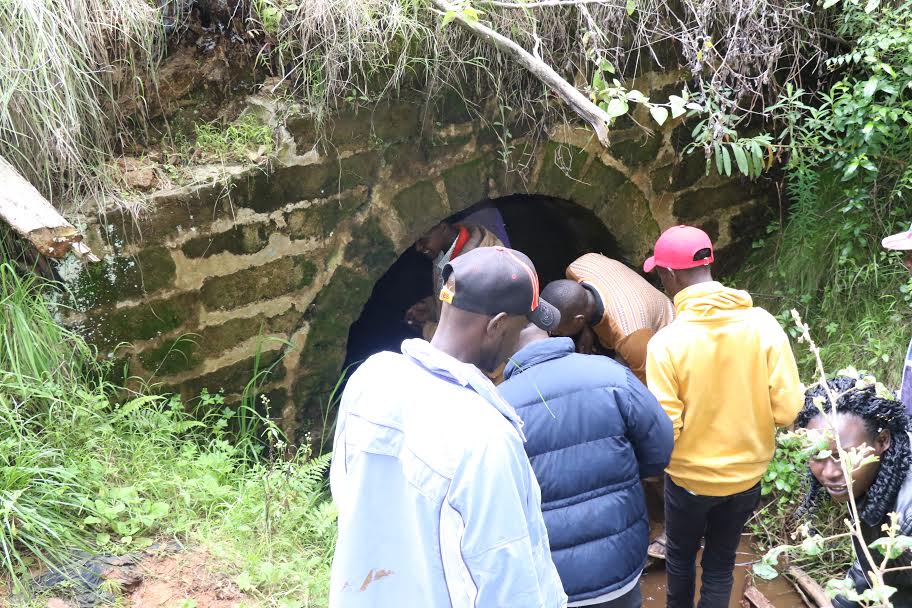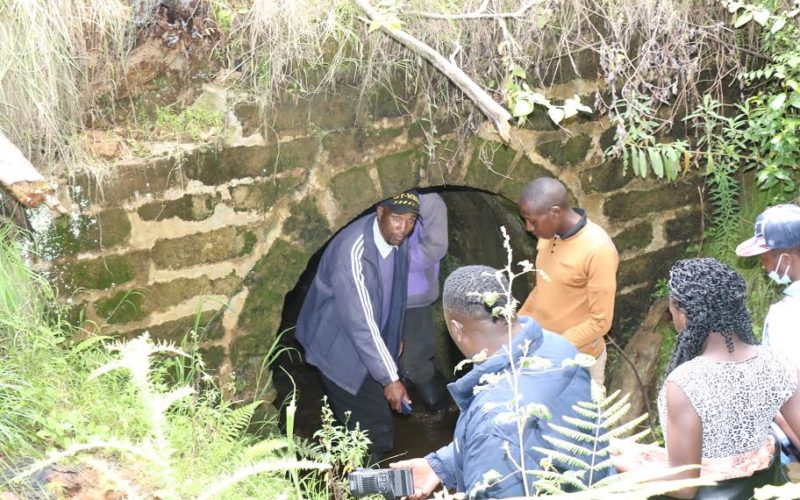Mysterious 76-year-old 6km tunnel discovered in Kenyan forest

Right at the centre of the majestic Mau Forest, lies a mysterious tunnel,whose rich history is waiting to be discovered.
Located about 80 metres below the ground at Mariasini bloc, the 76-year-old tunnel is believed to have been built by Italian prisoners of war between 1940 and 1944.
Little is known about this six-kilometre long brick-lined-arch-tunnel designed by British rulers, but what is clear is that local tourists from nearby villages of Nessuit and Marioshoni and drawn to it because of its mystic beauty.
Joseph Chemaina a village elder and a son to a home guard stationed at the tunnel before independence said little information was given on its main purpose.
He said the underpass was constructed between the years of 1940 – 1944 by Italian war prisoners and Kenyan slaves fetched as far as Marsabit and Kakamega.
“My father was a home guard employed by the colonial government and he told me much about the place. He said it was cleaned every morning after which a routine inspection was conducted,” said Chemaina.
He observes that to date the passage remains a mystery.
Though Chemaina believes that the tunnel could have held many secrets, he disputes that the place was a military training ground for the British army and a holding ground for prisoners.
According to Chemaina before the country attained independence the place used to be heavily guarded with no one allowed close to the site without authorisation.
Having been in the tunnel several times, Chemaina notes that the pathway has rooms and it is a sign people lived inside.

At the entrance, Chemaina says the place had a gate and a huge royal metal padlock with the inscription ‘ENG’ indicating it was made in England.
The once heavily-guarded site is now deserted, and only the adventurous souls can beat the pitch darkness and flooded floors to witness the antiquity and secrets it hides.
Built with precision, the underpass was curved out from one of the hills in the forest and has chambers and rooms believed to have been used as stores.
Locals say the tunnel is a ‘time capsule’, giving fascinating insights into war-time life, with graffiti and names covering sections of the walls.
Juan Suarez – is among the first names to have been found inscribed onto the walls, but today locals write their names too as a sign of their travel conquest.
The tunnel is about 1.5 metres wide and seven feet high at the main entrance however, the height narrows as you move further inside up to around four feet.
Surprisingly, there is sufficient oxygen supply in the tunnel thanks to the structural design that allowed installation of two breathers after every one meter on both sides.
Now the tunnel is home to bats and owls who act as guards of its hallowed secrets. Most people are scared of going into the tunnel the sounds of clicking and hooting from the two mammals scares them away.
According to residents few have managed to walk through the furthest end where the rooms are believed to be stationed as stories of flashlights mysteriously turning off frighten explorers.
They say as you make your way into the tunnel there is no social distance as you have to be close to your group and talk with loud tones so as to remain sane.
After every metre there is a mark to show how far one has gone.
At the fifth stretch, which opens way to the unopened rooms, the walls have crumbled blocking the entrances. Also,root intrusion and corrosion of some of the metals has caused severe damage to the brick-and-masonry structure.
Chemaina says the place has become a tourist attraction, however lamenting that the neglect and reluctance by the government is too loud to make something out of the place.
According to Chemaina, the community wants to convert the place into a cultural centre in order to benefit locals living around.
“The government is not interested in preserving let alone guard the tunnel, if resources are pumped through the Ministry of Tourism then be assured this a place people will not miss to visit, however if nothing is done people with ill intentions can use the opportunity to bring in illegal items and use the place as a criminal hideout,” he added.
Bito Lang’at, another resident said a lot of tales have been told about the place noting that a number of generations currently occupying the land know little about the tunnel.
From allegations that the place was used a torture chamber, a military armory for the British army and a water tunnel are some of the claims he says cannot be confirmed as none of the items pointing to the three have been found.
He observed that the main purposes of the tunnel remain a mystery to many, saying its complex construction and rooms inside leaves a history gap among many residents in the area saying more research has to be done.
Lang’at noted that the place has at least six rooms and different openings, which he believes used to hold people, with writings on some of the walls with unexplained characters all over.
He wants the tunnel to be preserved as it has developed cracks allowing water to sip in from the walls above ground, saying that it would be unfortunate if the state would allow such a site to crumble.
According to him, the place has ten sections stretching at least 500 metres each with different height levels with the longest stretch believed to be one kilometre long.
“The government should come in a survey the place and determine if it can be gazetted to be a tourist attraction site and ensure the place is safeguarded,” said Lang’at.
Gideon Cheboi echoed the calls to have the place rehabilitated and preserved so as to benefit the locals and the government through tourism.
He said the nature of which the tunnels were constructed has stunned all residents who to date do not use stones for construction of their structures.
“We used to go to the tunnels for walks and exploration while we were young despite the tales that flashlights do not work past the seventh section where many do not pass,” said Cheboi.









